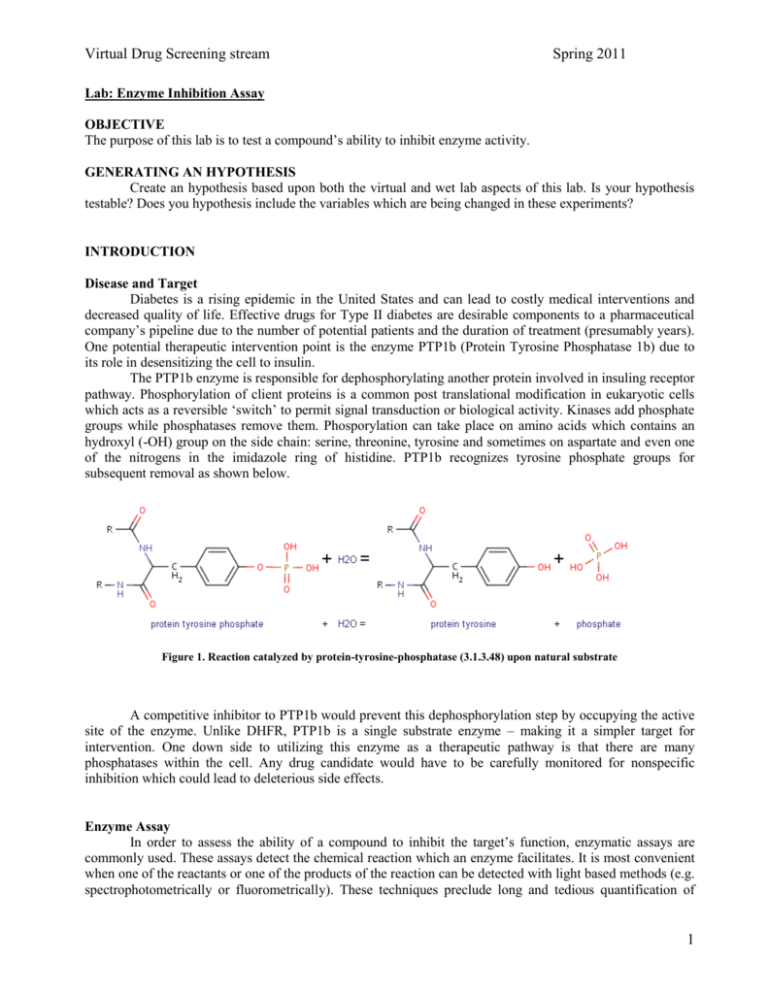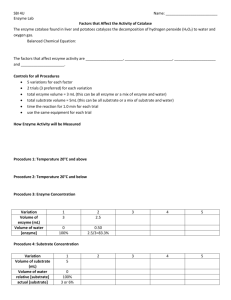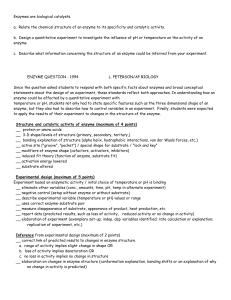Lab 8: Protein purification
advertisement

Virtual Drug Screening stream Spring 2011 Lab: Enzyme Inhibition Assay OBJECTIVE The purpose of this lab is to test a compound’s ability to inhibit enzyme activity. GENERATING AN HYPOTHESIS Create an hypothesis based upon both the virtual and wet lab aspects of this lab. Is your hypothesis testable? Does you hypothesis include the variables which are being changed in these experiments? INTRODUCTION Disease and Target Diabetes is a rising epidemic in the United States and can lead to costly medical interventions and decreased quality of life. Effective drugs for Type II diabetes are desirable components to a pharmaceutical company’s pipeline due to the number of potential patients and the duration of treatment (presumably years). One potential therapeutic intervention point is the enzyme PTP1b (Protein Tyrosine Phosphatase 1b) due to its role in desensitizing the cell to insulin. The PTP1b enzyme is responsible for dephosphorylating another protein involved in insuling receptor pathway. Phosphorylation of client proteins is a common post translational modification in eukaryotic cells which acts as a reversible ‘switch’ to permit signal transduction or biological activity. Kinases add phosphate groups while phosphatases remove them. Phosporylation can take place on amino acids which contains an hydroxyl (-OH) group on the side chain: serine, threonine, tyrosine and sometimes on aspartate and even one of the nitrogens in the imidazole ring of histidine. PTP1b recognizes tyrosine phosphate groups for subsequent removal as shown below. Figure 1. Reaction catalyzed by protein-tyrosine-phosphatase (3.1.3.48) upon natural substrate A competitive inhibitor to PTP1b would prevent this dephosphorylation step by occupying the active site of the enzyme. Unlike DHFR, PTP1b is a single substrate enzyme – making it a simpler target for intervention. One down side to utilizing this enzyme as a therapeutic pathway is that there are many phosphatases within the cell. Any drug candidate would have to be carefully monitored for nonspecific inhibition which could lead to deleterious side effects. Enzyme Assay In order to assess the ability of a compound to inhibit the target’s function, enzymatic assays are commonly used. These assays detect the chemical reaction which an enzyme facilitates. It is most convenient when one of the reactants or one of the products of the reaction can be detected with light based methods (e.g. spectrophotometrically or fluorometrically). These techniques preclude long and tedious quantification of 1 Virtual Drug Screening stream Spring 2011 products through other means. Alternatively, other assays which do not detect the chemical reaction of an enzyme but rather the binding of a ligand to the target can be utilized. These binding assays can be based upon fluorescence, radioactivity, heat or many other signals. The downside to using binding assays for enzymes is that they do demonstrate if the compound is inhibiting the function or just that it is attaching to the enzyme. Almost any of these assays can be done on a small scale by hand to test the efficacy of a few potential ligands or they can be scaled up robotically to screen thousands of compounds at a time – this is called high throughput screening (HTS). The natural substrate for our enzyme of interest (PTP1b) is phosphorylated tyrosine residues. However, this is not a convenient choice to use in the enzyme assay. While the tyrosine does absorb light that the spectrophotometer can detect, the wavelength would be the general 280 nm one which other aromatic residues in the protein (phenylalanine and tryptophan) would also absorb. Alternatively, we can use a surrogate substrate that will be recognized by the enzyme and absorb light in the wavelength region which our spectrophotometers can measure. For this assay we will use PNPP (p-nitrophenyl phosphate). Cleavage of this compound by the hydrolase activity of PTP1b, it yields p-nitrophenol and free phosphate. In the last step of the enzyme assay, we add NaOH which acts as a strong base and deprotonates the p-nitrophenol. The resulting anion absorbs light at 410 nm with an extinction coefficient of 18,200 M-1cm-1. Figure 2. Reaction catalyzed by general phosphatases upon surrogate substrate In any scientific experiment, it is important to have control samples to make sure everything is working. For this enzyme assay, we will have a negative control which lacks enzyme. The idea is that if there is no enzyme present, we should not see a change in our signal (absorbance). The next ones are the positive controls. These samples contain the enzyme and everything it needs to carry out the chemical reaction but there is not an inhibitor (compound) present. Consequently, an increase in signal confirms that our enzyme is actually working. The last control that is added is a positive inhibition control. For this sample, a known inhibitor of PTP1b called Orthovanadate is added to the tube at a concentration that is known to stop the action of the enzyme. A decrease in signal would be expected. Components of an enzyme assay (i.e. what’s in the tube) Enzyme – this is pretty obvious. It is the protein which carries out the reaction Substrate – the molecule(s) that the enzyme converts in the reaction Products – this is what the substrate will turn into after the chemical reaction Cofactors – none for PTP1b, but would be other necessary components (e.g. NADPH for DHFR) Metal ions – PTP1b is not a metalloenzyme, but we will have some Magnesium in the reaction Buffer – maintains pH Solvent - water Compound – this is the potential inhibitor. We will be testing a range of concentrations because we don’t know how much is required to get inhibition (if any). Solvent for compound – DMSO works well for most compounds because it interacts with both polar and nonpolar molecules NaOH – added last to deprotonate p-nitrophenol and make it absorb light at the 410 nm wavelength. 2 Virtual Drug Screening stream Spring 2011 Important Steps Pre-incubation – is done to allow the compound to bind the inhibitor before substrate is present Substrate addition – pNPP is added to all the tube at the same time This step should be done quickly! Incubation – after the substrate is added the reaction is kept at 37OC This step should be done quickly! Addition of stop solution – the NaOH stops the reaction by altering the pH and de-protonates pnitrophenol to p-nitrophenylate anion at the same time This step should be done quickly! After the NaOH is added, you can relax. The absorbance will be stable for up to an hour. LAB SAFETY Wear a glasses and gloves while handling reagents and wash your hands after removing your gloves and before exiting the lab. We will be working with a strong base (NaOH) and compounds for which the toxicity is unknown (potential inhibitors). Also, the enzyme could potentially be a biological hazard as well. EXPERIMENTAL PROCEDURE See Excel spreedsheet FOR THE LAB REPORT Physico-chemical Properties Look up your compound information (Lipinski’s properties, etc.) on the tested compounds you may have already done this for the VS3 Bestranking table. Chembridge – https://www.hit2lead.com/ Go to Screening Compounds, Search by ID Maybridge – http://www.maybridge.com/ Login as VDSclass@gmail.com Password is painter214 Go to Screening Compounds, Use the Cat_No in the SDF file to search for the ligand. Remove the final letters. e.g. KM10410SC needs to be changed to ---> KM10410 Also Ryan Scientific has info on Maybridge ligands Extent of Reaction Calculation Question: how much substrate did each reaction use up? Using Beer’s law and the molar extinction coefficient of the cleaved substrate in NaOH listed above, calculate the molar ratio of reactant (pNPP) to product (pNP-) in each of your reactions (A…I). Using Excel® will help you with the calculations. You already know the starting molarity of the pNPP since it is listed on the Enzyme assay protocol sheet. This can go into your Results section 3 Virtual Drug Screening stream Spring 2011 Lab report You can use LabWrite for some guidance (http://www.ncsu.edu/labwrite/ ) • The report should be at least 2,000 words • • • • • • • Intro & Background (~500 words) Include information of PTP1b and why it is a good target. You can look at the paper we read for journal club and the paper for the PDB file that you chose for the Virtual Screening. Go to the PDB website (www.pdb.org) for a link to the paper. Talk about the compounds screened – why did we chose them. Lastly, talk briefly about why we use enzyme assays. Hypothesis – 1-2 sentences Materials & Methods: (~500 words) – Concise but clear with a good flow. – Virtual Screening – don’t be overly detailed since we have done these steps before – Enzyme assay procedure – use final concentration of reagents when possible Results (keep this separate from Discussion section) – Bestranking table from Virtual Screening embedded into Word® with Lipinski’s info – Images of binding poses for the 3 ligands listed in the VS3 protocol – How long did your runs take for the 1st Run and 2nd Run? – Enzyme Assay graph – Brief results Paragraph of findings • State factual observations • Do the compounds follow Lipinski’s rule of five? • Is the enzyme active? • Doe the signal increase or decrease when compound is present? Discussion – Discuss your data. Was your compound any good? What does the Enzyme Assay data tell you? Do the results correlate with the Virtual Screening data? Was your hypothesis disproved? Conclusion (<100 words) – Summarize what you did and its significance – Future directions: How could you use this specific data in future research – be somewhat specific about what kinds of experiments or procedures would be expected. References – use ACS style format like in the Literature Search Exercise – Include the paper from your PDB file, include the PTP1b journal paper – Include this Lipinski paper for the Lipinski’s Rule of Five: Lipinski, C. A.; Lombardo, F.; Dominy, B. W.; Feeney, P. J., Experimental and computational approaches to estimate solubility and permeability in drug discovery and development settings. Adv Drug Deliv Rev 2001, 46 (1-3), 3-26. • Appendix – Include printouts of GOLD configuration files for each of your 2 runs Submission The report is due at midnight on Wednesday May 4th Convert to PDF , Save filename as shown below, and send via email to Dr. B YourUTEID_YourName_LabVS3_EnzymeAssay.pdf Lab Notebook - due at 5:00 on Thursday May 5th Turn in your Lab Notebook to the drawer in PAI 2.14 and then go celebrate Cinco de Mayo 4







